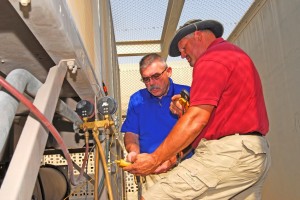Energy Efficiency Jobs
HVAC technicians are critical to the installation and maintenance of energy efficient HVAC systems and processes.
HVAC technicians are critical to the installation and maintenance of energy efficient HVAC systems and processes.
Heating and air conditioning (HVAC) mechanics and installers which are often referred to as HVAC technicians jobs play an important role in the going green movement due to the increasing demand for energy efficient products. HVAC mechanics and installers work on installing, repairing and maintaining heating, ventilation and cooling systems in residential, industrial and commercial buildings. These green job holders rely on blueprints, design specifications, and manufacturer instructions to install new HVAC systems or repair defective HVAC systems. With the demand for energy efficiency, they often need to replace old HVAC systems with new energy star rated HVAC systems. They reassemble and test equipment after an installation or repair to ensure the HVAC system meets all specifications required for optimal energy efficiency. To maintain quality and ensure that there aren’t any air leaks, HVAC mechanics and installers use pressure gauges or soap-and-water solutions to test pipes or tubing joints for leaks. They also join pipes or tubing to equipment and use electrical testing tools to test the circuits or components for continuity. Some of the common tools used by HVAC technicians are hand tools such as wrenches, electric drills, pipe cutters and benders, acetylene torches, and hammers to connect parts to duct work, and to install, connect, and adjust thermostats, humidistats and timers. The following are tools HVAC mechanics and installers may use in their job:
 HVAC mechanics and installers also need to obtain and maintain required certifications for the Energy Star program in order to qualify for managing and installing energy efficient HVAC systems. They also need comply with all standards, policies and procedures, including safety and clean work space procedures.
HVAC mechanics and installers also need to obtain and maintain required certifications for the Energy Star program in order to qualify for managing and installing energy efficient HVAC systems. They also need comply with all standards, policies and procedures, including safety and clean work space procedures.
Heating, air conditioning, and refrigeration mechanics and installers usually work in homes, schools, hospitals, office buildings, or factories. One of the work conditions that we should note is that their job sites may be very hot or cold because they job usually need to repair broken heating and cooling systems. HVACR technicians working outdoors are exposed to all types of weather. Most work at least a 40-hour week. During peak seasons they often work overtime or irregular hours including evenings and weekends.
Obtaining a green career as a heating, air conditioning, and refrigeration mechanic and installer usually requires an associate’s degree, training in vocational schools and related on-the-job experience. Previous work related experience, skills or knowledge usually improves the chances of obtaining the job. Because heating and air conditioning (HVAC) systems are complex, especially with green energy and energy efficient technology, employers generally prefer applicants with technical training or those who have completed a formal apprenticeship. The following are recognized apprenticeable specialties associated with this occupation: Heating-and-Air-Conditioning Installer-Servicer; Furnace Installer-and-Repairer, Hot Air; Furnace Installer; Oil-Burner-Servicer-and-Installer; Air and Hydronic Balancing Technician. Some states and localities require technicians to be licensed. Employees in this job typically require one or two years of training with the aid of other experienced workers as part of their on-the-job experience. This job usually involves using communication and organizational skills in order to effectively communicate with customers, coordinate work and manage or train others.
The Bureau of Labor Statistics (BLS) indicates a bright outlook for Heating, air conditioning, and refrigeration mechanics and installers and expects employment of this field to grow 29 to 34 percent from 2010 until 2020; this is much faster than the average for all jobs which is about 14%. The increasing in demand for trained HVAC technicians, especially in green energy will result in excellent employment opportunities. The BLS projected 137,600 job openings between 2010 and 2020, and noted 268,000 Heating, air conditioning, and refrigeration mechanics and installers jobs are currently filled. Job title examples are HVAC Mechanic, HVAC Installer, Service Technician, HVAC Technician, HVAC Service Technician, HVAC Specialist or AC Tech. The BLS further reports that the median annual wage for salaried Refrigeration mechanics and installers was $43,380 in 2011 with median hourly wage of $20.86.